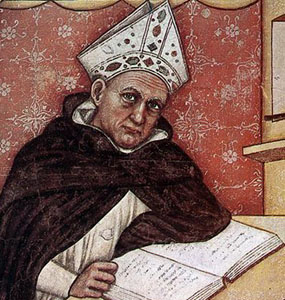Albertus Magnus (1193–1280)

Albertus Magnus was a German scholastic philosopher and experimenter; the teacher of Thomas Aquinas. His main significance was in promoting the study of Aristotle and in helping to establish Aristotelianism and the study of the natural sciences within Christian thought. In science he did important work in botany and was possibly the first to isolate arsenic.
Albertus Magnus, Count of Bollstädt, was born at Lauingen, in Swabia. After finishing his studies at Padua, he entered the lately founded order of the Dominican friars, and taught in the schools of Hildesheim, Ratisbon, and Cologne, where Thomas Aquinas became his pupil. In 1245 he became provincial of the Dominican order in Germany. In 1260 he received from Pope Alexander IV the bishopric of Ratisbon. But in 1262 he retired to his convent at Cologne to devote himself to literary pursuits, and there he composed many of his works.
Like his English counterpart Roger Bacon, Albertus wrote about black powder and how to make it. A recipe appears in his De mirabilis mundi (On the Wonders of the World):
Flying fire: Take one pound of sulfur, two pounds of coals of willow, six pounds of saltpeter; which three may be ground very finely into marble stone; afterwards ... some may be placed in a skin of paper for flying or for making thunder.
The extensive chemical and mechanical knowledge which, considering the age in which he lived, Albertus possessed, brought upon him the imputation of being a sorcerer and magician. Jammy, a Dominican, published the works of Albertus in 21 folio volumes in 1651; and some of them, as also the apocryphal De Secretis Mulierum attributed to him, were published separately. The most notable are the Summa Theologiae and the Summa de Creaturis.
Albertus surpassed all his contemporaries in the breadth of his learning; he was not inaptly dubbed the doctor universalis. He was not so remarkable for originality; and was to the best of his ability a follower of Aristotle as presented by Jewish, Arabian, and western commentators. He stood midway between realism and nominalism in philosophy, and did more than any predecessor to bring about the union of theology and Aristotelianism which was the basis of scholasticism. Both in physics and metaphysics he mainly repeated Aristotle.


